
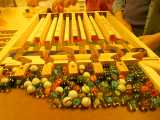


|
|
|
|
Why Voting Systems Matter:
A tabletop demonstration for children and adults of several unusual voting systems
Peter A. Taylor
Based on a presentation at Bay Area UU Church, April 4th, 2012.
Photos by Carol Phillips unless otherwise noted.
 |
 |
 |
 |
The Borda Count and the "clone" problem
Once upon a time, the Eschatology Committee at my church; Larry, Moe, and Curly; decided to go out for pizza. When they got to the restaurant, there were four kinds of pizza on the menu: (A) Pepperoni, (B) Pepperoni and Ham, (C) Pepperoni and Canadian Bacon, and (D) Veggie. It turns out that two of the three people on the committee, Larry and Moe, are vegetarians, but the third, Curly, is a pepperoni lover. If the choices had been limited to Pepperoni or Veggie, Veggie would have won, 2-1. But they decided to be scientific, and use a point system that included all four of the candidates. A first choice pick was worth 3 points, second choice was worth 2 points, third choice was worth 1 point, and last choice was worth nothing. This system is called the Borda Count.
 |
 |
 |
 |
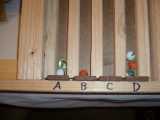 |
The way the Borda computer works is that there are four colored voting sticks, one for each candidate. You place the stick representing your first choice in the bottom slot on the computer, then your second, third, and fourth choices above the first, in that order. To cast your vote, pull the slide to the right to load the six marbles, then to the left to release them into the four slots, in the distribution [3,2,1,0]. The column with the most marbles wins.
Larry voted first. His first choice was (D) Veggie. His second choice was (A) Pepperoni, which was only one meat. His third and fourth choices were two-meat pizzas, (B) Pepperoni and Ham and (C) Pepperoni and Canadian Bacon. The point totals after Larry voted were:
| (A) | (B) | (C) | (D) |
| Pepperoni | Pepperoni and Ham | Pepperoni and Canadian Bacon | Veggie |
| 2 | 1 | 0 | 3 |
Larry really didn't want Pepperoni, but he had to pick something for second place.
Moe's thinking was exactly the same as Larry's. After Moe voted, the point totals were
| (A) | (B) | (C) | (D) |
| Pepperoni | Pepperoni and Ham | Pepperoni and Canadian Bacon | Veggie |
| 4 | 2 | 0 | 6 |
Curly's first choice was (A) Pepperoni. His second choice was (B) Pepperoni and Ham. He didn't really like ham, but he was willing to put up with it in order to get pepperoni. His third choice was (C) Pepperoni and Canadian Bacon. Again, he didn't really like Canadian bacon, but he was willing to put up with it in order to get pepperoni. His last choice was (D) Veggie. The final point totals, after Curly voted, were
| (A) | (B) | (C) | (D) |
| Pepperoni | Pepperoni and Ham | Pepperoni and Canadian Bacon | Veggie |
| 7 | 4 | 1 | 6 |
(A) Pepperoni won, even though the vegetarians outnumbered the pepperoni lovers 2-1.
This problem is called "cloning." (B) Pepperoni and Ham and (C) Pepperoni and Canadian Bacon are "clones" of (A) Pepperoni: they are close substitutes. Nobody liked (B) or (C) as well as (A), but their presence on the ballot threw the election from (D) to (A). The Borda Count is said to be "vulnerable to cloning."
The Borda Count and the "burying" problem
The next time the Eschatology Committee went out for pizza, Larry and Moe decided to make sure they didn't get (A) Pepperoni by putting it on the bottom of their lists of preferences. Specifically, Larry and Moe each listed their preferences in the exact opposite order from what Curly did the previous time. The point totals after Larry voted were
| (A) | (B) | (C) | (D) |
| Pepperoni | Pepperoni and Ham | Pepperoni and Canadian Bacon | Veggie |
| 0 | 1 | 2 | 3 |
The point totals after Moe voted were
| (A) | (B) | (C) | (D) |
| Pepperoni | Pepperoni and Ham | Pepperoni and Canadian Bacon | Veggie |
| 0 | 2 | 4 | 6 |
Curly voted his sincere preferences, just like last time. The final point totals after Curly voted were
| (A) | (B) | (C) | (D) |
| Pepperoni | Pepperoni and Ham | Pepperoni and Canadian Bacon | Veggie |
| 3 | 4 | 5 | 6 |
(D) Veggie won.
This tactic of putting your archrival at the bottom of your list of preferences is called "burying." Larry and Moe actually preferred Pepperoni to the other two meat pizzas, but they buried it underneath the less preferred pizzas because they thought it was more likely to win. Their tactic worked. The Borda Count is "vulnerable to burying."
More burying using the Borda Count
The third time the Eschatology Committee went out for pizza, Curly decided that he would vote insincerely, too. Larry and Moe voted the same way they did the previous time: (D) Veggie, (C) Pepperoni and Canadian Bacon, (B) Pepperoni and Ham, and (A) Pepperoni. Just like last time, the point totals after Larry voted were
| (A) | (B) | (C) | (D) |
| Pepperoni | Pepperoni and Ham | Pepperoni and Canadian Bacon | Veggie |
| 0 | 1 | 2 | 3 |
The point totals after Moe voted were
| (A) | (B) | (C) | (D) |
| Pepperoni | Pepperoni and Ham | Pepperoni and Canadian Bacon | Veggie |
| 0 | 2 | 4 | 6 |
But Curly decided that he would give his first preference to a candidate that came close to winning last time, rather than his sincere favorite. Curly chose (C) Pepperoni and Canadian Bacon, (B) Pepperoni and Ham, (A) Pepperoni, and (D) Veggie. The final point totals after Curly voted were
| (A) | (B) | (C) | (D) |
| Pepperoni | Pepperoni and Ham | Pepperoni and Canadian Bacon | Veggie |
| 1 | 4 | 7 | 6 |
(C) Pepperoni and Canadian Bacon won. This was Larry's and Moe's last choice, and Curly's second to last choice, if they had voted sincerely. Burying can produce strange and perverse results.
Condorcet and cloning
Now let's try another election system called Condorcet, also known as Pairwise Runoff. This system goes through the candidate list in pairs, looking at all the possible pairings, trying to find a candidate who would have defeated all of his rivals in one-on-one races. If we find one, he's called the Condorcet winner, and he's elected. But it's also possible to have a rock-paper-scissors situation. In that case, we need a circular tiebreaker.
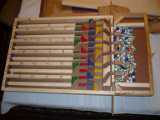 |
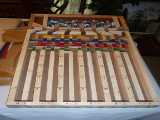 |
 |
 |
 |
The Condorcet computer is similar to the Borda computer. There are four colored voting sticks for four candidates. You put the stick representing your favorite candidate in the bottom slot, and the others in order above it, second, third, and fourth. To cast your vote, pull the slide to the right to load six marbles, then to the left to release them. But this time, instead of four columns with several marbles each, we have twelve columns, or six pairs, with one marble for each pair. The pairs represent the races A vs. B, A vs. C, A vs. D, B vs. C, B vs. D, and C vs. D. The voting sticks divert marbles from column to column within any one column pair, but they never allow marbles to hop from one pair to another pair. The total number of marbles is always the same for each column pair.
Suppose the Eschatology Committee had voted sincerely using the Condorcet system. Larry's preference order is D, A, B, C. In other words, Larry supports D over each of A, B, or C. Larry also supports A over B or C. And he supports B over C. After he votes, there is one marble each in columns A→B, A→C, A←D, B→C, B←D, and C←D.
| A vs. B | A vs. C | A vs. D | B vs. C | B vs. D | C vs. D |
| 1 - 0 | 1 - 0 | 0 - 1 | 1 - 0 | 0 - 1 | 0 - 1 |
Using the Condorcet system, Larry's opinion of A relative to B is separate from his opinion of A relative to C, or C relative to D.
Moe votes exactly the same way Larry does, so after Moe votes, there are two marbles in each of these columns.
| A vs. B | A vs. C | A vs. D | B vs. C | B vs. D | C vs. D |
| 2 - 0 | 2 - 0 | 0 - 2 | 2 - 0 | 0 - 2 | 0 - 2 |
Curly's sincere preference order is A, B, C, D. The final result after Curly votes is A→B, A→C, A←D, B→C, B←D, and C←D.
| A vs. B | A vs. C | A vs. D | B vs. C | B vs. D | C vs. D |
| 3 - 0 | 3 - 0 | 1 - 2 | 3 - 0 | 1 - 2 | 1 - 2 |
(D) Veggie, has defeated each of the other candidates, 2-1, so Veggie is the Condorcet winner. As long as a Condorcet winner exists, the Condorcet system is "cloneproof."
Condorcet and burying
Now let's repeat the third example, where everyone voted insincerely, but this time using Condorcet. Larry and Moe voted D, C, B, A. After Larry votes, we have
| A vs. B | A vs. C | A vs. D | B vs. C | B vs. D | C vs. D |
| 0 - 1 | 0 - 1 | 0 - 1 | 0 - 1 | 0 - 1 | 0 - 1 |
After Moe votes (also D, C, B, A), we have
| A vs. B | A vs. C | A vs. D | B vs. C | B vs. D | C vs. D |
| 0 - 2 | 0 - 2 | 0 - 2 | 0 - 2 | 0 - 2 | 0 - 2 |
Curly voted C, B, A, D. The final result this time is A←B, A←C, A←D, B←C, B←D, C←D.
| A vs. B | A vs. C | A vs. D | B vs. C | B vs. D | C vs. D |
| 0 - 3 | 0 - 3 | 1 - 2 | 0 - 3 | 1 - 2 | 1 - 2 |
(D) Veggie is still the Condorcet winner. As long as a Condorcet winner exists, the Condorcet election system is proof against "burying."
Condorcet and compromise (revised 9-14-2022)
Another nice feature of Condorcet is that compromise candidates do well. Suppose we have an international moon base with 5 German, 4 Korean, and 3 Norwegian astronauts voting on how to configure the food replicator (the food replicator is really hard to re-configure). The four choices are sauerkraut, kimchee, kipper snacks, and oatmeal. The Germans like sauerkraut, and are willing to put up with oatmeal, but they don't like kimchee or kipper snacks. The Koreans like kimchee, and are willing to put up with oatmeal, but they don't like sauerkraut or kipper snacks. The Norwegians like kipper snacks, and are willing to put up with oatmeal, but they don't like kimchee or sauerkraut. Here's what their ballots look like:
| Germans (5 astronauts) | Koreans (4 astronauts) | Norwegians (3 astronauts) | |
| First Choice | Sauerkraut (A) | Kimchee (B) | Kipper Snacks (C) |
| Second Choice | Oatmeal (D) | Oatmeal (D) | Oatmeal (D) |
| Third Choice | Kipper Snacks (C) | Sauerkraut (A) | Kimchee (B) |
| Fourth Choice | Kimchee (B) | Kipper Snacks (C) | Sauerkraut (A) |
Oatmeal is nobody's first choice, but everyone's second choice.
If we run the election using Instant Runoff Voting (IRV), the system the Australians use in their lower house (aka the Alternative Vote, AV), here's what happens: We assign each ballot to the candidate who was ranked first on that ballot, and then we count the votes. We are looking for a candidate with a majority of support, which is seven votes. No candidate has seven votes, so we eliminate the candidate with the fewest votes, and reassign each of those ballots to whichever candidate is ranked next. Repeat until there is a majority winner.
 |
 |
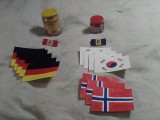 |
| (A) Sauerkraut | (B) Kimchee | (C) Kipper Snacks | (D) Oatmeal | |
| 1st round | 5 | 4 | 3 | 0 |
| 2nd round | 5 | 4 | 3 | - |
| 3rd round | 5 | 7 | - | - |
Oatmeal, with zero first place votes, is eliminated in the first round. There are no ballots to redistribute. Kipper Snacks, with three votes, is eliminated in the second round. The Norwegians' three votes would go to their second choice, but Oatmeal has already been eliminated, so these ballots go to the third choice, Kimchee, instead. This gives Kimchee seven votes. Kimchee wins, even though a 2/3 majority of the voters (5 Germans and 3 Norwegians) would have prefered oatmeal.
If we run the election instead using Condorcet (pairwise runoff), the compromise candidate wins.
| (A) Sauerkraut vs. (B) Kimchee |
(A) Sauerkraut vs. (C) Kipper Snacks |
(A) Sauerkraut vs. (D) Oatmeal |
(B) Kimchee vs. (C) Kipper Snacks |
(B) Kimchee vs. (D) Oatmeal |
(C) Kipper Snacks vs. (D) Oatmeal |
| 5 - 7 | 9 - 3 | 5 - 7 | 4 - 8 | 4 - 8 | 3 - 9 |
Oatmeal (D) wins 7-5 over Sauerkraut (A), 8-4 over Kimchee (B), and 9-3 over Kipper Snacks (C), so Oatmeal is the Condorcet winner. Oatmeal wins even though it had no first place support at all. Condorcet is unusual this way. Usually, in runoff elections, the candidates that don't have very much first place support are eliminated early, even though they might have a lot of second or third place support.1
A circular tiebreaker for Condorcet (Tideman/Schulze)
What happens when there is no Condorcet winner? We get a circular tie. How do you break a circular tie? The answer is to count the marbles, and give priority to the most lopsided victories, the ones with the most marbles.
Suppose we have 25 voters who vote this way:
Click to examine the candidates in more detail.
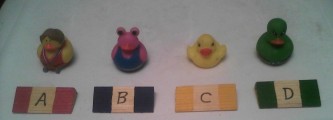
| Number of voters | First choice | Second choice | Third choice | Fourth choice |
| 7 | B | C | D | A |
| 8 | C | D | A | B |
| 6 | A | D | B | C |
| 3 | A | B | D | C |
| 1 | A | B | C | D |
Here's what we end up with in the Condorcet computer:
| A vs. B | A vs. C | A vs. D | B vs. C | B vs. D | C vs. D |
| 18 - 7 | 10 - 15 | 10 - 15 | 17 - 8 | 11 - 14 | 16 - 9 |
Every candidate has been defeated at least once. That means that there is no Condorcet winner. So we need a circular tiebreaker.
 |
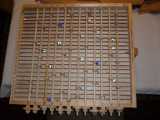 |
 |
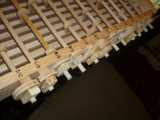 |
 |
 |
The way the tiebreaker computer works is that there are 24 columns, each one representing one way of breaking a circular tie. There are also 12 shafts representing the 12 possible pairwise victories in the Condorcet computer (12 columns of marbles). The shafts come in pairs, and I made the knobs on the ends of the shafts in a funny shape so that you can only turn one of the two shafts up at a time. When you turn one of the shafts, you "lock" one of the pairwise victories. That way you can never tell the tiebreaker computer that A defeats B and B defeats A at the same time. Each of the 24 tiebreaker columns has one marble in it. The movements of the 24 marbles are controlled by cams that are attached to the 12 shafts. When a marble reaches the bottom of its column, that tells us another victory that we have to lock in order to make sure that we don't have a circular tie, even if that means ignoring what the Condorcet computer says.
In this example, the tallest column of marbles in the Condorcet computer is A→B, with 18 marbles. B has lost, so we flip over his nametag. Then we turn the A/B shaft 180 degrees on the tiebreaker computer to lock the victory. We look for a marble to fall to the bottom, but nothing happens. We go back to the Condorcet computer and empty the marbles from the A vs. B column pair.
The next tallest column of marbles is B→C, with 17 marbles. C has lost, so we flip over his nametag, even though he was beaten by someone who also lost. Then we turn the B/C shaft 180 degrees on the tiebreaker computer to lock the victory. This time, a marble falls to the bottom of the A/C column. What this tells us is that A has a "beatpath" to C that has a lot of marbles backing it up.2 Since we lock the victories in the order of how many marbles they have, we know that the beatpath from A to C has more marbles than whatever is in the A vs. C column pair on the Condorcet computer.
Let's check. A beat B with 18 marbles, and B beat C with 17 marbles. The smaller of the two numbers is 17 marbles, so the beatpath from A to C has a strength of 17 marbles. If we look in the A vs. C column pair, we see that C beats A directly with 15 marbles. Sure enough, 17 is greater than 15. That checks, so we go back to what we were doing.
The marble at the bottom of the A/C tiebreaker column tells us to lock the A/C victory, so we turn the A/C shaft 180 degrees. No more marbles fall, so we go back to the Condorcet computer and empty the marbles out of the B vs. C and A vs. C column pairs.
The next tallest column of marbles is C→D, with 16 marbles. D has lost, so we flip over his nametag. That leaves A as the only candidate left. A is the winner.
A chart for resolving complicated ties
Whenever you take a vote in a small group, there is always the possibility of a tie. The way the US Senate deals with ties is that the Vice President, who doesn't normally get to vote, does get to vote as a tiebreaker. So I will ask someone to serve as a Vice President when we hold mock elections. If no one wants to, I will roll dice, and the dice will be Vice President.
But with an election system like Condorcet, we have a large number of different ways of having a tie. There are six pairs of candidates in my Condorcet computer. Any pair can be tied if there is an even number of voters. But even with an odd number of voters, if there is a circular tie, then I need to choose which of the six victories to "lock" first in the tiebreaker computer. Look closely at the Condorcet circular tiebreaker Final voting results table. Notice that the victories, A←C and A←D (the second and third column pairs), are tied for strength at 15 marbles. So on top of the circular tie, we also have a regular tie. It's possible for several pairwise victories to be tied for the largest number of marbles. Then I need to choose the second victory to lock, and so on. In my circular tiebreaker example, I had to go to a lot of trouble to come up with an interesting circular tie that didn't also need a regular tiebreaker.
The circular tiebreaker example I used in my April 4th presentation was simpler, and didn't have any regular ties, but I realized later that it was mathematically impossible to come up with a set of voters' preferences that would produce those results.
If someone volunteers to be Vice President, he or she can decide how to break ties on a whim, but if I have to roll dice, this can be so confusing that I need a chart. I have a four-sided and a six-sided die, which I will roll in order to come up with a "digital Vice President's" preference order and corresponding row in my chart. This row tells me the order in which to lock the pairwise victories. The chart tries to protect the Vice President's most preferred candidate as much as possible.
| d4 | d6 | VPpref | 1st | 2nd | 3rd | 4th | 5th | 6th | 7th | 8th | 9th | 10th | 11th | 12th |
| 1 | 1 | ABCD | A→D | A→C | A→B | B→D | B→C | C→D | D→C | C→B | D→B | B→A | C→A | D→A |
| 1 | 2 | ABDC | A→C | A→D | A→B | B→C | B→D | D→C | C→D | D→B | C→B | B→A | D→A | C→A |
| 1 | 3 | ACBD | A→D | A→B | A→C | C→D | C→B | B→D | D→B | B→C | D→C | C→A | B→A | D→A |
| 1 | 4 | ACDB | A→B | A→D | A→C | C→B | C→D | D→B | B→D | D→C | B→C | C→A | D→A | B→A |
| 1 | 5 | ADBC | A→C | A→B | A→D | D→C | D→B | B→C | C→B | B→D | C→D | D→A | B→A | C→A |
| 1 | 6 | ADCB | A→B | A→C | A→D | D→B | D→C | C→B | B→C | C→D | B→D | D→A | C→A | B→A |
| 2 | 1 | BACD | B→D | B→C | B→A | A→D | A→C | C→D | D→C | C→A | D→A | A→B | C→B | D→B |
| 2 | 2 | BADC | B→C | B→D | B→A | A→C | A→D | D→C | C→D | D→A | C→A | A→B | D→B | C→B |
| 2 | 3 | BCAD | B→D | B→A | B→C | C→D | C→A | A→D | D→A | A→C | D→C | C→B | A→B | D→B |
| 2 | 4 | BCDA | B→A | B→D | B→C | C→A | C→D | D→A | A→D | D→C | A→C | C→B | D→B | A→B |
| 2 | 5 | BDAC | B→C | B→A | B→D | D→C | D→A | A→C | C→A | A→D | C→D | D→B | A→B | C→B |
| 2 | 6 | BDCA | B→A | B→C | B→D | D→A | D→C | C→A | A→C | C→D | A→D | D→B | C→B | A→B |
| 3 | 1 | CABD | C→D | C→B | C→A | A→D | A→B | B→D | D→B | B→A | D→A | A→C | B→C | D→C |
| 3 | 2 | CADB | C→B | C→D | C→A | A→B | A→D | D→B | B→D | D→A | B→A | A→C | D→C | B→C |
| 3 | 3 | CBAD | C→D | C→A | C→B | B→D | B→A | A→D | D→A | A→B | D→B | B→C | A→C | D→C |
| 3 | 4 | CBDA | C→A | C→D | C→B | B→A | B→D | D→A | A→D | D→B | A→B | B→C | D→C | A→C |
| 3 | 5 | CDAB | C→B | C→A | C→D | D→B | D→A | A→B | B→A | A→D | B→D | D→C | A→C | B→C |
| 3 | 6 | CDBA | C→A | C→B | C→D | D→A | D→B | B→A | A→B | B→D | A→D | D→C | B→C | A→C |
| 4 | 1 | DABC | D→C | D→B | D→A | A→C | A→B | B→C | C→B | B→A | C→A | A→D | B→D | C→D |
| 4 | 2 | DACB | D→B | D→C | D→A | A→B | A→C | C→B | B→C | C→A | B→A | A→D | C→D | B→D |
| 4 | 3 | DBAC | D→C | D→A | D→B | B→C | B→A | A→C | C→A | A→B | C→B | B→D | A→D | C→D |
| 4 | 4 | DBCA | D→A | D→C | D→B | B→A | B→C | C→A | A→C | C→B | A→B | B→D | C→D | A→D |
| 4 | 5 | DCAB | D→B | D→A | D→C | C→B | C→A | A→B | B→A | A→C | B→C | C→D | A→D | B→D |
| 4 | 6 | DCBA | D→A | D→B | D→C | C→A | C→B | B→A | A→B | B→C | A→C | C→D | B→D | A→D |
Plurality Voting and the "spoiler" problem
More recently, the Epistemology Committee went out for pizza. They went to the same restaurant as the Eschatology Committee, but they had heard about the problems with the Borda Count, so they decided to use Plurality voting to choose a pizza. This is the system we use to elect US Congressmen, and is also called Single Member Plurality, SMP, or First Past The Post, FPTP. There is a list of candidates, and you have to pick one, and only one. There are no runoffs, so whoever gets the most votes wins even if this is a less than a majority. Hence the name "Plurality" rather than "Majority Runoff".
 |
 |
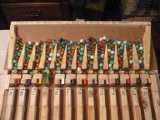 |
The Epistemology Committee had 9 people on it, and their preferences were:
| Number of voters |
First choice |
Second choice |
Third choice |
Fourth choice |
| 2 | (A) Pepperoni | (B) Pepperoni and Ham |
(C) Pepperoni and Canadian Bacon | (D) Veggie |
| 2 | (B) Pepperoni and Ham | (C) Pepperoni and Canadian Bacon |
(A) Pepperoni | (D) Veggie |
| 2 | (C) Pepperoni and Canadian Bacon | (A) Pepperoni |
(B) Pepperoni and Ham | (D) Veggie |
| 3 | (D) Veggie | (A) Pepperoni |
(B) Pepperoni and Ham | (C) Pepperoni and Canadian Bacon |
The results of the vote were:
| (A) | (B) | (C) | (D) |
| Pepperoni | Pepperoni and Ham | Pepperoni and Canadian Bacon | Veggie |
| 2 | 2 | 2 | 3 |
There were six people who liked some version of a pepperoni pizza and three who preferred veggie, but the pepperoni lovers didn't agree on which version of pepperoni they preferred, so the vegetarians won. This is called a "spoiler" problem. Instead of similar candidates helping one another, as in the "clone" problem, here they interfere with one another. (Condorcet is also proof against spoilers.)
Plurality Voting and "strategic" voting
The next time the Epistemology Committee went out for pizza, the pepperoni lovers realized that, in order to get a result that they were reasonably happy with, many of them needed to vote against their first choice, and support their second or third choice. This is called voting "strategically". But how do you know whom to vote for? The answer is that, in order to know how you should vote, you need to know how other people are likely to vote. You need public opinion polling information or something similar, like the results of a previous state primary election or caucus during a US Presidential primary campaign. Everyone on the Epistemology Committee guessed that Pepperoni would be more likely to win than the other two meat pizzas, so the pepperoni lovers all voted for straight pepperoni.
| (A) | (B) | (C) | (D) |
| Pepperoni | Pepperoni and Ham | Pepperoni and Canadian Bacon | Veggie |
| 6 | 0 | 0 | 3 |
This creates a self-fulfilling prophecy: a lot of people voted for Pepperoni because they expected a lot of people to vote for Pepperoni (and it wasn't Veggie). This tends to result in a two-party system in any country that uses Plurality Voting. This tendency in known as
Duverger's Law. Someone or some party gets himself or themselves established as the front-runner and someone else as the leading opponent. Voters can either support one of these two candidates, or else they can "throw their vote away". Part of the reason that "early money" is important in politics is that candidates can establish themselves as front-runner or leading opponent early in a primary campaign by spending a lot of money on advertising.
Approval Voting
There is a simple change to Plurality Voting that turns it into a very different system: instead of only allowing voters to pick one candidate, allow them to pick any number. Now you have Approval Voting.
 |
 |
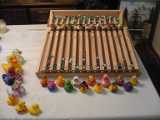 |
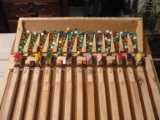 |
What would have happened if the Epistemology Committee had used Approval Voting instead of Plurality? The two Pepperoni voters might have approved Pepperoni and Ham or Pepperoni and Canadian Bacon as well. The Pepperoni and Ham, and Pepperoni and Canadian Bacon voters would have been very likely to approve Pepperoni. The results would have been likely to look something like this:
| Voter ID number |
(A) Pepperoni |
(B) Pepperoni and Ham |
(C) Pepperoni and Canadian Bacon |
(D) Veggie |
| 1 | Yes | Yes | No | No |
| 2 | Yes | No | Yes | No |
| 3 | Yes | Yes | No | No |
| 4 | Yes | Yes | Yes | No |
| 5 | Yes | Yes | Yes | No |
| 6 | Yes | No | Yes | No |
| 7 | No | No | No | Yes |
| 8 | No | No | No | Yes |
| 9 | No | No | No | Yes |
| Total | 6 | 4 | 4 | 3 |
Approval Voting is especially good if you have a large number of candidates, because you don't have to rank them, which can quickly get tedious with large numbers of candidates. It is cloneproof: adding an attractive second choice doesn't improve the prospects for your first choice. Since you don't rank your preferences, it is proof against burying: there is no list to bury a rival at the bottom of. It also tends to be resistant to spoilers.
But how do you know for whom to vote? As with Plurality Voting, in order to vote wisely, you need information on how other people are likely to vote. If you can make a good guess about which candidate is likely to win, you probably want to vote for anyone you like better than him, and against anyone you like less. Whether you should vote for the likely winner depends on how well you like whomever you think is next most likely to win.
Suppose that there are initially two candidates, Pepperoni and Veggie, and of the two, I prefer Pepperoni. Now suppose that Pepperoni and Ham enters the race, and I like Pepperoni and Ham even better. Is Pepperoni and Ham a spoiler? If I think Pepperoni and Ham has a good chance of winning, I may vote against Pepperoni for fear of helping Pepperoni defeat Pepperoni and Ham. If I'm wrong, and Veggie wins, with Pepperoni and Ham in third place after Pepperoni, then Pepperoni and Ham has acted as a spoiler. If I have better information, and know that Veggie is likely to win; and if I vote accordingly, by supporting both Pepperoni and Pepperoni and Ham, then Pepperoni and Ham is not acting as a spoiler.
Update, 12-8-2016, from a Facebook conversation:
Maine is experimenting with ranked ballots (specifically Instant Runoff Voting). My daughter asked me what I thought about it.
I keep changing my mind about whether or not I think it would make much difference. I'm feeling skeptical right now. I used to think that the problem with US politics was that two wasn't a big enough number of viable political parties. Now I think that one isn't a big enough number of intellectual fashion industries.
Note that they are talking specifically about Instant Runoff Voting (IRV). There are lots of different systems that use the same ranked choice ballots (e.g. Condorcet, Borda).
Also, I owe you an explanation of what the potential drawback is with Instant Runoff Voting (AKA the Alternative Vote).
There are two major kinds of election systems: single-seat and multi-seat.
Most of the horror stories about weird electoral systems involve proportional representation (PR), which requires multi-seat legislative districts. PR allows a small faction, with maybe just a few percent of the popular vote, to elect a "fringe candidate", someone who explicitly represents that faction, without having to compromise with other factions before the election. You can also end up with a legislature that has lots of political parties, not just two.
The single-seat election systems are basically Plurality (AKA First Past the Post), where you vote for only one candidate and there are no runoffs; and a whole bunch of different runoff systems, including Instant Runoff Voting (IRV, AKA the Alternative Vote, AV); plus a couple of other systems that produce results similar to runoff systems.
All of the single-seat systems have the characteristic that they force the political parties to compromise in order to attract voters from other parties, which tends to punish fringe candidates. In addition, Plurality (no runoffs) also forces voters to anticipate who the other voters are likely to support so that they don't "throw their vote away". Plurality voting is basically synonymous with "the two-party system" (this is called Duverger's Law).
I have two related questions for you. (1) Do you want fringe politicians to be able to win seats in the legislature? (2) Do you want there to be more than two parties in the legislature?
The disaster scenario with PR is that you often get a small fringe party that holds the balance of power between two large mainstream parties. The fringe party then ends up with almost as much power in practice as the major parties. Also, Maurice Duverger says that being able to win seats in the legislature changes the way in which fringe political movements evolve. So I'm pretty sympathetic to the view that PR is a bad idea.
What I'm not sure about is how quirky the legislature is likely to be if you don't have fringe parties in the legislature, but you still have more than two parties, so you still have a high chance of a small not-too-fringy party that holds the balance of power between two large parties.
Alternately, you could end up with the situation that I think they have in Australia (which uses the Alternative Vote in their lower house): there are more than two parties in the legislature, but they are in two large permanent coalitions with one another, so the effect is pretty much the same as if you only had two parties. So the difference between Plurality and "Instant Runoff" may not matter very much.
I'm looking forward to seeing how things turn out in Maine.
Notes:
1. I have more to say about Instant Runoff Voting (IRV). IRV is pretty good, but I like Condorcet better.
2. There are lots of different circular tiebreaker systems. The two systems invented by Nicolaus Tideman and Markus Schulze produce the same results, and I think they are the best. In order to break a circular tie, you have to overturn at least one pairwise victory. These systems make sure that the victory they overturn is the weakest one. My tiebreaker computer uses Tideman's method, but I explain how it works using the idea of a "beatpath," which comes from Schulze's method.
|
|
|
|